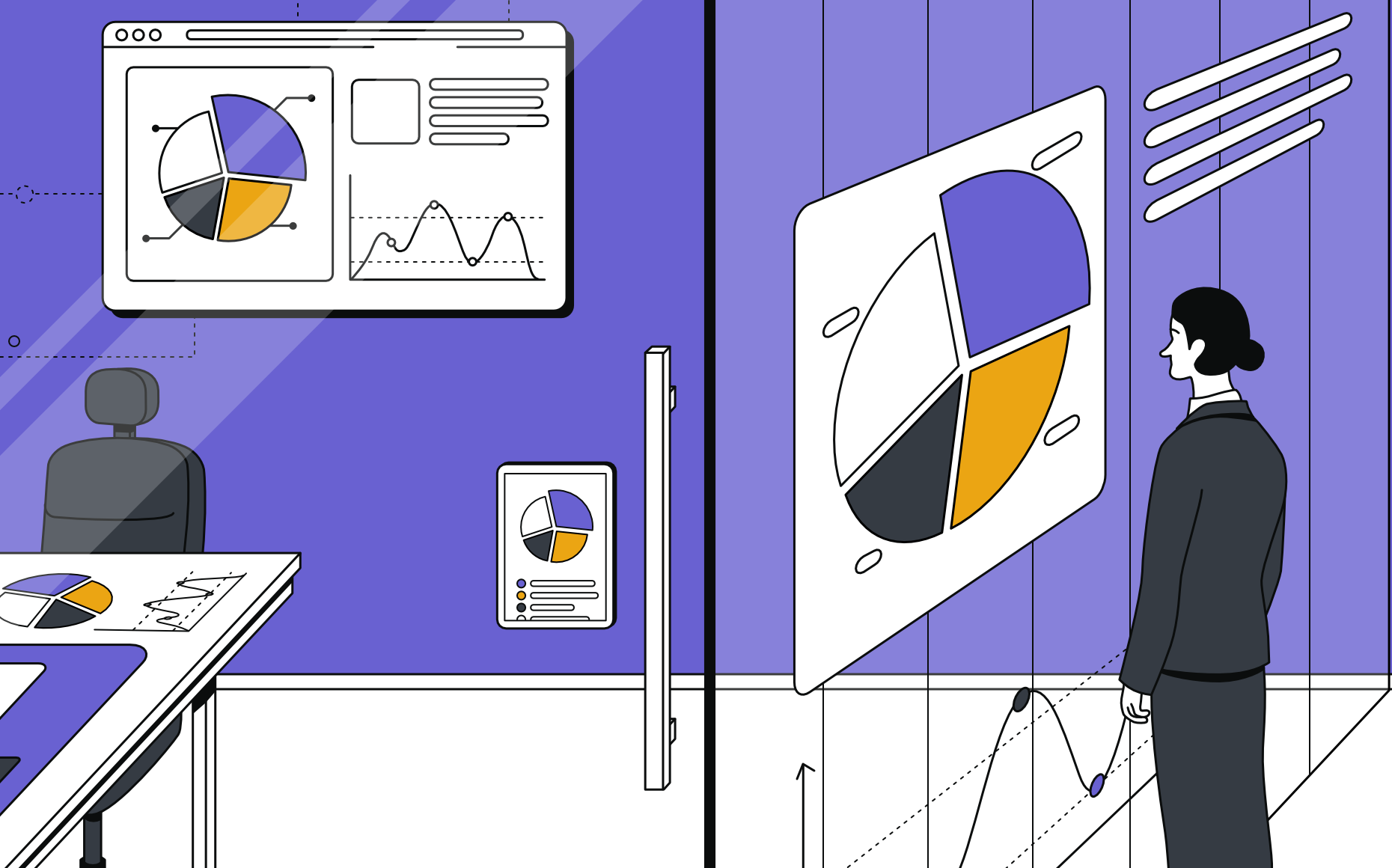At bipp, we like talking about data. A lot. And that’s not surprising, considering what we do for a living. The data conversation continues to evolve as we head into a new year. And another orbit around the Sun seems as good a time as any to gaze intently into bipp’s crystal ball. Here, then, are some ideas on what we think will be driving the data analytics and BI conversation in 2022 and beyond.
1. The Data-Driven Company is Dead - Long Live the Culture of Analytics
While we’ve dined out on data-driven enterprises for some time, it’s time for a shift in focus. If we’ve learned anything from the dark years of COVID, it’s that using data to inform decisions is the key to business growth and dynamism. For example, sales leaders can respond to dips in revenue down to the individual product and store level. At the same time, HR can combine external workforce data with historical trends to adjust salaries and benefits to reduce churn.
But…and it’s a big BUT…simply adding a BI platform to your business application stack doesn’t create a data-driven enterprise. Instead, it merely creates more headaches for many IT or BI teams.
Using this lead-a-horse-to-water approach to up-skilling, these apps are just another tool to learn, and, given the lack of intuitive design that many BI tools suffer from, they are quickly discarded. As a result, while people across a business will all intellectually understand the potential benefits of a BI platform, they’re not all data-literate.
True benefits come from a cultural change. And if you don’t take proactive steps to create a culture, one will be created around you (or despite you). This is especially true for analytics and BI.
In 2022, the emphasis has to shift, which will force changes on both the platform developer side and within the companies themselves. Self-service BI alone doesn’t create change. Selecting tools that busy business users can easily navigate is a good start. But, beyond a slick interface is a need for robust data models that act as enterprise-wide single sources of truth. If you’re not investing time to define a layer that hosts business logic to be explored by the rest of your organization, then self-service BI will do nothing except create an endless series of helpdesk tickets.
Give people access to tools on their terms by embedding dashboards in the intranets or apps they know. Create trust by ensuring everyone uses the same language to represent critical KPIs and clean data. And combine hands-on training with a platform that can scale your business, recognizing the cultural shift required to take enterprise-wide advantage of BI.
2. Data Modeling Layers Bring Self-Service (BI) Power to the People
The self-service BI theory is excellent. Its logic borrows heavily from Kevin Costner’s 1989 classic, ‘Field of Dreams,’ in which corn farmer Ray Kinsella uttered the iconic line, “If you build it, they will come, (well, ‘he’ will come, if you’re a stickler for details). Kinsella referred to a baseball diamond he built in his cornfield and the hope that baseball players from past eras (including his father) would return. But in life (as in baseball-in-cornfield movies), just because you build something doesn’t mean they’ll come.
We all get the logic. Self-service - bypassing IT - means business users can better react to opportunities and solve problems. But this creates conflict. IT’s remit is to protect infrastructure, preserve the single source of truth, and ensure copies of data don’t spread like demented tribbles across the business. This can fly in the face of the end-users’ desire for flexibility, preference for their tools, and ability to work independently.
Self-service falls down in three key areas:
-
Chaotic Business Metrics
BI tools need data. Not rocket science. But if each unit is creating its definitions and metrics in a large company, it creates chaos when you’re comparing reports across units. Without a centralized model, the business falls out of alignment. This means each group draws different conclusions, and no one will trust the numbers.
-
Business Users Aren’t Data Engineers.
Most business folks run a mile from math. But some self-service options force business users to spend an increasing amount of time managing data. And ultimately, the mess they create will end back up with IT. So while the business should certainly get hands-on with visualizations and dashboards, they shouldn’t have to play engineer when the data changes.
-
Self-Service Doesn’t Scale
Yes, the business wants to be more agile. And self-service can undoubtedly help by speeding up time-to-insight. But when a business unit grows or needs to scale metrics across multiple brands, the wheels start to fall off. Sure, self-service BI tools are faster than waiting for issue tracking tickets to be resolved but aren’t agile enough for fast-growth companies.
2022 is the year to get self-service right.
IT can be agile enough to support self-service with a data modeling layer by defining reusable data models in one place. SQL expressions and statements represent the layer, which hosts the business logic (so KPIs and metrics are consistent). Modern data modeling layers are built for today’s complex data but should include visual data models, making it easy to create powerful data models without writing code. Instead, teams should interact with the database schema using simple drag-and-drop columns and make edits in real-time.
With this in place, self-service business users can make decisions based on the same trusted logic as the same language represents critical KPIs. For example, they can create dashboards, trust their visualizations and easily filter them in real-time. Which means they’re making decisions based on the latest, real-time information.
3. The Ayes (Eyes!) Have IT
I hate to look at the negatives. But sometimes, they’re the best way of finding a positive. So bear with me a little here. You see, bipp was created to help all businesses derive insights from data to help make informed decisions. This is a big bumper sticker (and don’t get me started on our business cards), but it’s something we kind of like. But, unfortunately, while this is a great, big, hairy goal, it’s one we’ve discovered that can be beyond the reach of some companies. And it’s not always for the reasons you’d think.
The first challenge is, weirdly, SQL data modeling (see prediction number two). We knew how critical data modeling was. Single source of truth, reusability, collaboration, yadda, yadda, yadda. And we created an easy-to-use language, which streamlined SQL, included dynamic analytic functions, reduced the complexity of your data stack, and connected directly to your data warehouse. And you know what? People love it! Just…not all data teams love having to learn a new language (even one that uses only 31 keywords).
The second challenge? Not everyone can code. This will come as a shock to many readers. But it’s a sad reality. So if a BI solution is dependent on coding skills, then it may not be the right one for your company, no matter how great the visualizations and dashboards are. We realized you shouldn’t have to learn a programming language to get insights from your data, especially if you’re committed to building a data culture but don’t have a vast data analytics team.
So we live in a world where we want better tools (but don’t want to learn a new language necessarily) and where we don’t want to learn any language at all. In 2022, we’ll solve this problem.
The answer to these challenges? The ayes (eyes!) have it. We perceive up to 80% of all impressions using our sight. And in an age of no-code/low-code, self-service tech, we’d better embrace the vision-first world of BI. Specifically, data engineers reluctant to learn new languages to create data models will need visual data models. They’ll generate data models with a powerful point-and-click visual interface. And can interact with the database schema using simple drag and drop columns. Analysts can make edits in real-time and test the model before committing with a data preview pane. They have access to all of the features of language-created models without writing any code.
And for those who want to quickly extract and manage data and build charts without programming knowledge? The answer in 2022 will be visual SQL, which lets them blend data and create charts from disparate sources without going through an ETL pipeline. Using an intuitive, flexible drag-and-drop interface, users across a business will explore and visualize data on their terms. And the best part? They can visually connect to leading databases, and quickly extract and manage data, build charts, and dashboards, all without programming knowledge.
4. The Revolution Will be Augmented
The last time I looked at the Gartner Hype Cycle for Analytics and Business Intelligence, augmented analytics was hovering around the trough of disillusionment. For those that don’t follow Gartner’s visual approach to analyzing the maturity and adoption of technologies and applications, this means interest in a topic is waning as experiments and implementations fail to deliver. They predict producers of the technology will fail, and investments will only continue if the surviving providers improve their products. The good news? Those that survive the trough edge up the slope of enlightenment before breaking through to the plateau of productivity.
Gartner geography aside, we think augmented analytics is on the fast track in 2022. There are a couple of reasons for this. First, 1.145 trillion MB of data is created every day. Enabling technologies such as machine learning and AI, quite frankly, have to assist with data preparation, profiling, cleaning, joining, exploration, and insight generation/explanation.
With all companies proudly proclaiming themselves to be data companies, augmenting how people explore and analyze data in analytics and BI platforms is no longer a nice-to-have. However, there are only so many analysts, engineers, and data scientists, so augmented analytics will be the actual driver of mainstream adoption.
At bipp, we think the feature that will drive this is augmented analysis. Users - and those they report to - need to understand how an insight was generated, whether there’s potential bias or any risks with the underlying data. The augmented analysis takes critical business metrics and lets the platform explore millions of combinations, determine the highest impact, reveal these as facts, and prioritize them in order of importance. All without needing to understand a query language, such as SQL. And with natural language generation, platforms will be able to respond to queries in English and provide context on visuals so users can generate - and justify - insights faster.
The keys here are speed and accuracy. This type of augmented analysis is designed for processing data at scale. And underpinned by trusted data models and being in-database (so processing is conducted within the database), we feel it will help migrate companies from analytics anxiety to analytics culture.
5. The Year of the Data Engineer
Time’s Person of the Year in 2021 was Elon Musk. Sure, the tweeting king of electric cars, Boring Companies, SpaceX, and flame-throwers has undeniably done a lot for humanity (and crypto) over the past 12 months. But we think there’s a new (well, old?) player that has a good shot for 2022. And that’s the not-so-humble data engineer.
Data engineers were systems builders, data transporters, and back-end engineers in the days gone by. Today’s data engineer moves, shapes, and defines data from generated to consumed. They build data pipelines and efficiently store data for tools that need to query it. Critically, they analyze the data and ensure it adheres to data governance rules and regulations.
Data engineers have to bolt and chain tools together with code as they strive to simplify the data stack. The reality is, data engineering has gotten harder, especially with new compliance requirements like GDPR and CCPA. Teams now have to evaluate new tools, work out how to integrate them with existing tools, and set up DevOps practices to incorporate them in the data stack in sync with local and global legislation. Success requires a strong correlation between DevOps adoption and the implementation of a data governance program.
The data engineering skillset is ideal for a business-critical technical problem. Every business must enable teams with the best tooling while maintaining a unified, flexible data layer. Engineers will need to architect and operate data stacks that solve these problems and be responsible for machine learning, analytic reporting, and decision management.
At the heart of this is their SQL skills. Armed with this skill, they can read and understand database execution plans, how indices work, the different join algorithms, and the distributed dimension.
Entity-relationship data modeling should also be a reflex, along with a clear understanding of normalization, plus sharp intuition around denormalization tradeoffs. The data engineer should be familiar with dimensional modeling and the related concepts.
With these core skills, data engineers will become 2022’s most critical business and technical partners, charged with removing the schism between IT/engineering and other disciplines.
Watch out, Elon Musk; the data engineers are coming for you…







